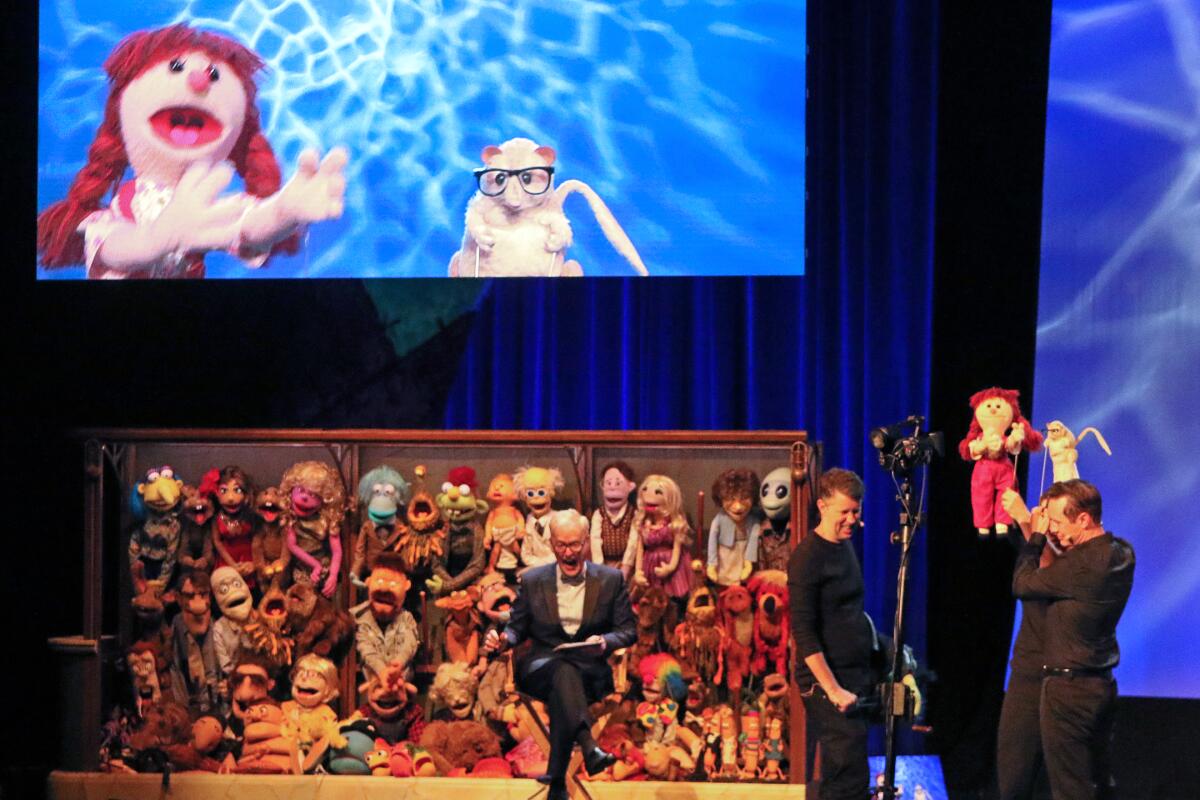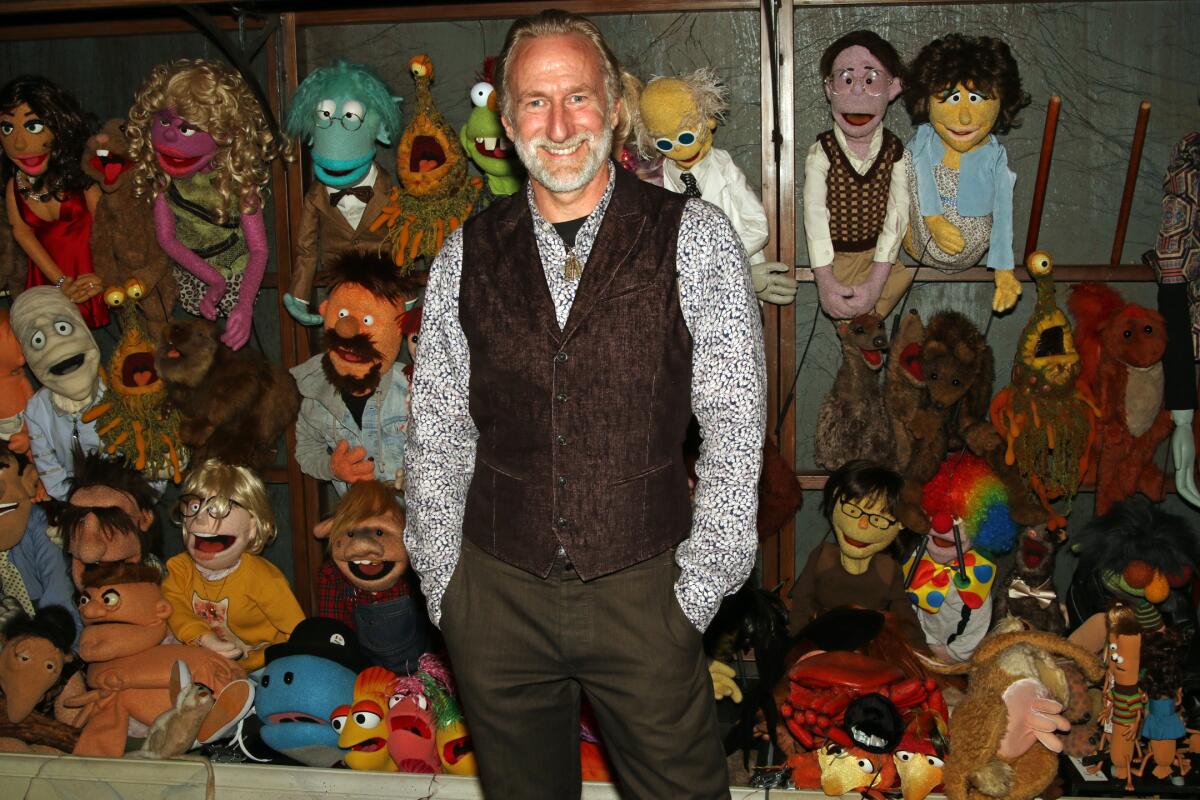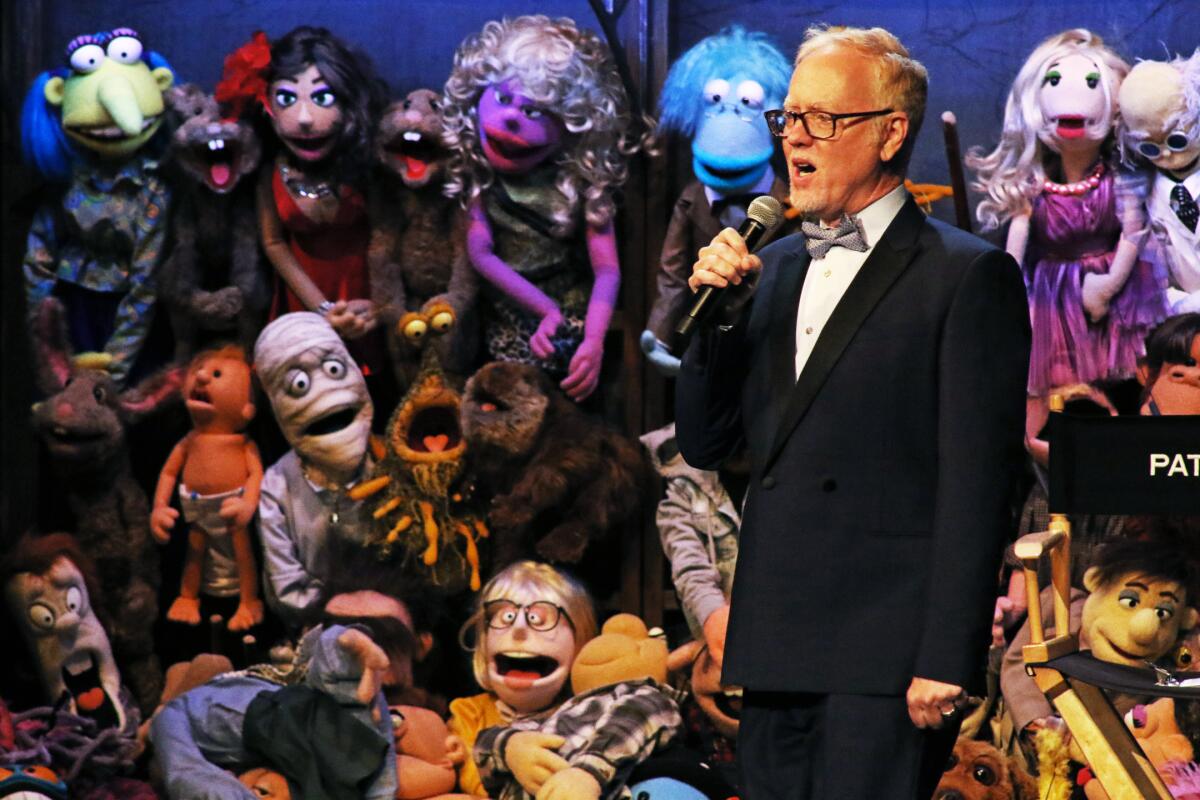How a show inspired by Jim Henson infuses personality into puppetry using adult improv

- Share via
The name Henson has been synonymous with puppets for around 50 years. Many of Jim Henson’s popular franchises and co-productions, such as “Fraggle Rock,” “The Muppet Show” and “Labyrinth,” have played key roles for generations in children’s education and entertainment. However, Henson was evidently frustrated with being principally regarded as a kids’ entertainer.
From some of his early TV work — including the “Land of Gorch” sketches on “Saturday Night Live “— he attempted to shake the typecasting. But despite several efforts, the label generally stuck with him. After Jim Henson’s death in 1990 at age 53, his son Brian was named president of Jim Henson Productions Inc. In 2005, after the Henson family had sold and reacquired the company, the Henson Alternative brand was launched; since then, this label has served as an umbrella for more mature content.
The first show to emerge under the new banner was “Jim Henson’s Puppet Improv,” which is now known, internationally, as “Puppet Up! — Uncensored.” On the eve of tickets going on sale for a series of Los Angeles-based dates in July for the popular adult puppet show, The Times spoke with creators Brian Henson and Patrick Bristow about the show’s origin, the unique hybrid of puppetry and improv comedy, and its L.A. roots.
The idea to fuse improv with puppeteering originated from a training exercise meant to ween puppeteers from their dependence on scripts.
“One thing that I had become increasingly aware of was the puppeteers had become script-bound, literally to the point that if the performer before them missed one word in their line, the next performer wouldn’t know what to do,” Henson recalled. “And they didn’t have to memorize their dialogue because they were sticking up all of their lines around the monitors and stuff like that. ... We were trying to find some other really funny tones for puppetry that sort of differentiated from the Muppet tone and sensibility [led us to try new things.]”
Henson started trying new techniques with comedy writers, but nothing clicked right away, partly because the writers weren’t fully aware of what puppets can and can’t do, Henson said.
“So then I thought, ‘We’ll get together a core bunch of puppeteers, and we’ll start just discovering a new tone of comedy.’ When my dad was alive, we used to say we would get about one or two performers out of every 40 that we trained that could — [a] magic word to my father — ‘ad-lib,’” Henson said. “My dad was a great ad-libber; Frank Oz is a great ad-libber, and that always pluses up the comedy.”
The next piece of the puzzle came from actor Mia Sara (“Birds of Prey,” “Ferris Bueller’s Day Off”)—now married to Henson— who advised him that the style of comedy he was looking for was improv — only he’d never actually seen an improv comedy show.

She took him to a Groundlings show, and suddenly everything clicked for Henson. “Wouldn’t it be great if we could teach the puppeteers to do the magic ad-libbing that my father never thought was teachable?’” he said. The next step was Sara introducing Henson to actor, comedian and improv expert Patrick Bristow to help Henson with his show.
For those who haven’t experienced any of L.A.’s improv theaters ( such as the Groundlings, Upright Citizens Brigade, Improv LA), the ensemble performers take audience suggestions of character relationships, situations and occupations, and improvise thoughtful scenes or even multi-act stories based on the occasionally tasteless offerings.
Integrating this performance style into puppeteering had its own challenges. Henson recalled, “Patrick got together with me; we talked about [a collaboration]; and he said, ‘It’s gonna be hard because the most important rule to improv is you watch the other performer’s eyes.’ When we’re puppeteering, we all look at monitors that show us what the puppets are doing.” The pair put together a workshop and met once or twice a week for three hours with a team of puppeteers, set up a camera and monitors in the studio, where Bristow taught Henson about improv. Before long, the success of the workshops evolved into the show.
“[It turned out that] puppeteers could watch each other’s puppets and read what the puppeteer is thinking almost as well as watching another actor’s eyes,” Henson said. “I started inviting writers to listen in on what we were doing, so they could kind of get this different sort of tempo and energy, and then Patrick said, ‘Let’s put it all up in front of an audience; let’s just do a show.’” Henson was reluctant at first; after all, a longstanding tradition in most of puppetry involves obscuring the puppeteers from the audience’s view. But the two eventually decided that it would be great entertainment for audiences to see the screens, which showcase the puppets, as well as the puppeteers.
“The first show was just for friends and family on the lot; we did it in our L.A. studio, and it was great,” Henson recalled. “The reaction was really fantastic. And Patrick was right that as soon as you added a live audience, it sort of upped the stress level of the performers and sharpened up the comedy and sharpened up the entertainment value.”
The show immediately began to catch on. “One of our staff invited the producers of the Aspen Comedy Festival,” Henson said. “And they invited us to Aspen; I think that was in 2006. That was the very first time we went onstage for a public audience, and I think it had the auspicious title of ‘The Jim Henson Company’s Experimental Improv Puppetry Show.’”
After the troupe was invited to Edinburgh‘s Fringe Festival, Henson and company arrived at the title “Puppet Up! — Uncensored.”
“Puppet Up! — Uncensored” went on to tour multiple countries and has also gained the attention of SoCal audiences through its residencies at Knott’s Scary Farm, which Bristow referred to as the abbreviated “chamber version” of the show. Henson pointed out that the full show includes additional types of puppetry, such as digital puppets (animated in real time), additional video layering performances, and reenactments of classic Jim Henson puppet scenes.

Given that improv comedy can elicit lowbrow and risqué suggestions from audiences, we asked Bristow, who is the show’s director, the extent to which puppets affected the relationship between performers and audience members. “Because it’s puppets and it’s uncensored, the audience is definitely more uncensored themselves,” he said. “Also, regarding a lot of the risqué or the edgier humor that happens, the puppets get away with much more.”
“With a human improv performer, they’re going to hold you responsible for what you just said, in character or not, they may or may not forgive you,” Bristow continued . “The puppets, by virtue of just being these rascals — and it being heightened and one or two degrees away from reality — they get away with murder, literally. They can murder a likable character, and the audience laughs.”
Notwithstanding the puppet forgivability factor, the solicitation of uncensored comments from a crowd in a #MeToo world — and within an era of “cancel” culture — this invitation poses a risk to performers whose core sensibility routinely relies on their fearlessness to tackle any and all topics.
Bristow addressed the challenges of this age. “The landscape has definitely changed over the decades that I’ve been doing this, but I just look at it as almost another improv suggestion,” he explained. “Like, ‘Can you deliver this comedy that is palatable, that maybe still has a little bit of satiric teeth, but within today’s kind of implied limits, and make it something that everyone can laugh at and have a good time with, regardless of their politics or their sensitivity?’ That’s always the goal.
“And because it’s Henson, there’s an unspoken inclusiveness already,” Bristow said.
More to Read
The biggest entertainment stories
Get our big stories about Hollywood, film, television, music, arts, culture and more right in your inbox as soon as they publish.
You may occasionally receive promotional content from the Los Angeles Times.











